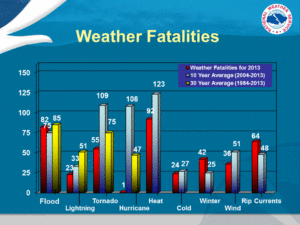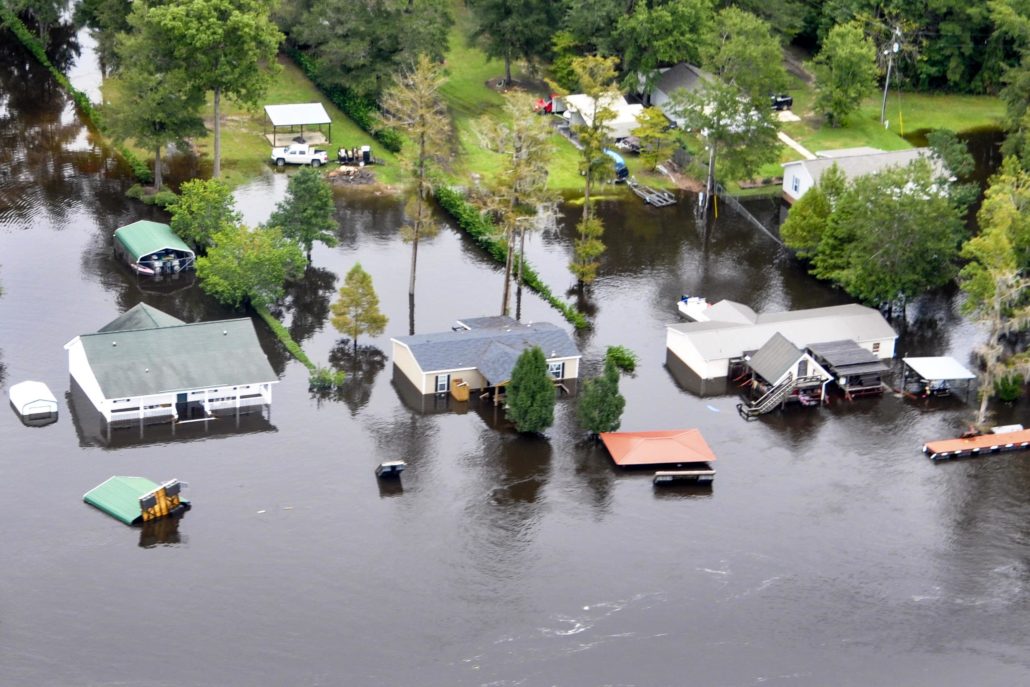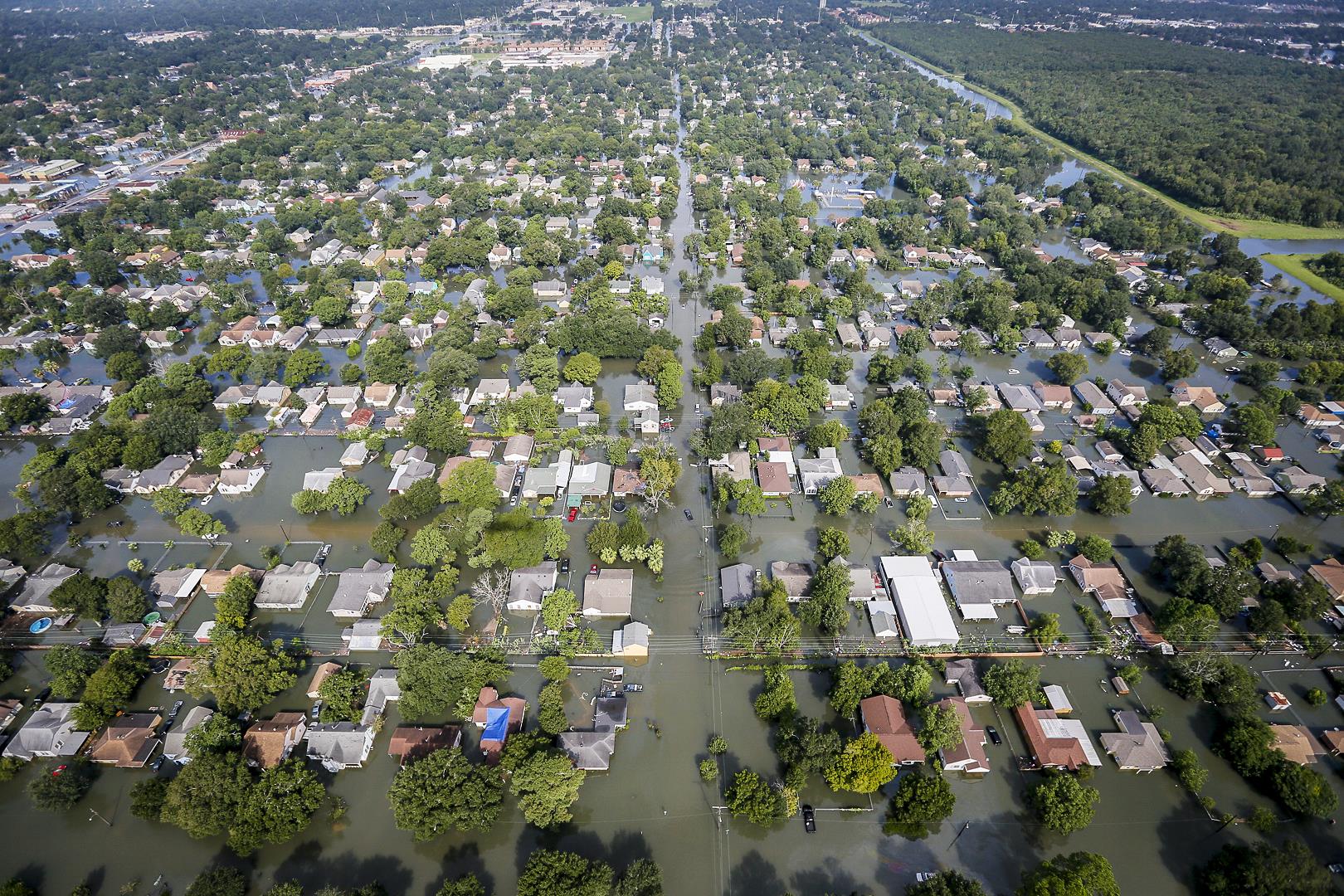When most people think of natural disasters, the first thing to come to mind is not likely flooding. However, flooding is the most common natural disaster. Flooding occurs in all 50 states, accounts for 40% of natural disasters, averages 5 billion dollars in damage each year, and claimed an average of 75 lives per year over the last 30 years.

According to the 30 year average, flooding is responsible for the most weather-related fatalities.
TYPES OF FLOODING
River and Lake Flooding
River and lake flooding is probably what most people envision when they think of floods. Heavy rainfall or snowmelt can cause water levels to rise overflowing banks and levees. River flooding is common in the Midwest as rain and snowmelt swells the tributaries that feed into larger rivers downstream. Once the water level crests the river banks, the area that is inundated can be widespread. Low lying areas, saturated soils, and urban areas can further exacerbate the effects of the overflow and take days to dissipate.
California experienced flooding in February when a weekend of storms increased runoff from Anderson Lake and flooded low-lying areas of San Jose. The early year storms also prompted the evacuation of over 88,000 people near the weakened Oroville Dam.
In May of 2017, heavy rainfall over the Midwest caused widespread flooding. Nearly 15 inches of rain fell over multiple states, saturating soils, and swelling multiple rivers above historic levels. Numerous levees were breached which flooded towns causing an estimated $1.7 billion dollars in damages to homes, businesses, and infrastructure.

Coast Guard overflight of South Carolina flooding
Coastal Flooding and Storm Surge
A form of flooding happens regularly along coastlines due to the cycle of rising and lowering tides. Tides are a regular rise and fall of sea level caused by the gravitational interplay of the sun, moon, and earth. Occasionally, these tides can be exceptionally high. An increase of just a few feet is more than enough for tides to breech natural and man-made barriers. Many coastal cities are very near, or in some cases lower than, sea level making them especially prone to any change in sea level.
Storm surge can also cause extreme coastal flooding. The surge develops during severe weather, hurricanes, and tropical storms raising sea level as much as 25 feet. Sea level rise is the result of the low atmospheric pressure found in these storms which has a similar effect on sea level rise as the gravitational pull on tides. High winds common with these storms also cause large waves to batter the coast and push water farther inland. In worst case scenarios, the storm surge strikes the coast during a high tide cycle, increasing the flooding exponentially. Storm surge flooding is responsible for 90% of hurricane related deaths and the majority of the damage to structures.
In August of 2017, Hurricane Harvey alone caused over $125 billion dollars in damage and killed 89 people. The majority of the devastation caused by Harvey was a direct result of the widespread flooding of the Houston area.
Flash Floods
Flash floods can result from a variety of causes, but the common denominator is that they develop quickly and are normally caused by heavy rainfall. These floods can also be the result of snow melt, dislodged ice, inadequate urban drainage, or dam breaks. The actual volume of water carried in a flash flood is usually less than other flood types but the water is channeled down confined spaces which causes it to move with devastating force and speed. Because of this speed, flash floods are very dangerous, easily carrying mud, rocks, and trees in its flow. A Weather Channel article stated that, “water flowing at 7 mph has the equivalent force per unit area as air blowing at EF-5 tornado wind speed.” Whereas, “water moving at 25 mph has the pressure equivalent of wind blowing at 790 mph, faster than the speed of sound.”
BASIC SAFETY AND PREPAREDNESS
Ready.gov provides many helpful tips.
Be Mindful
- Stay tuned to phone alerts, TV, or radio for weather updates, emergency instructions, or evacuation orders.
- Avoid walking or driving through flood waters. 6 inches of moving water can knock a person over, and one foot of moving water can sweep a vehicle away. According to the Environmental Protection Agency, the leading cause of flood-related injury and death is individuals attempting to drive through flood waters.
- Do not drive over bridges that are over fast-moving floodwaters. Floodwaters can scour foundation material from around the footings and make the bridge unstable.
- If there is a chance of flash flooding, move immediately to higher ground.
Protect your home
- Know your flood risk, avoid building in flood plains, and consider buying flood insurance.
- If you have to evacuate due to flooding, and if safety permits, turn off all the utilities to your home and attempt to move valuables to the highest possible level.
SOURCES
https://www.ready.gov/floods
https://www.nssl.noaa.gov/education/svrwx101/floods/types/
https://www.ncdc.noaa.gov/billions/events/US/2017-2018
http://www.floodsite.net/juniorfloodsite/html/en/student/thingstoknow/hydrology/floodtypes.html
https://weatherology.com/articles/106/The+Dangers+of+Flash+Floods.html
https://weather.com/storms/severe/news/power-flood-water-20130704
https://www.livescience.com/23913-flood-facts.html





One Comment